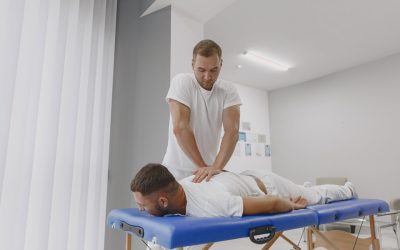Trigger point therapy is a highly effective method for alleviating muscle pain and discomfort. By targeting specific trigger points, this manual therapy technique can provide optimal results in pain relief. Whether you’re dealing with chronic pain syndrome or seeking post-injury rehabilitation, incorporating trigger point therapy into your wellness routine can significantly improve your overall well-being.
Understanding how trigger points can cause muscle pain is crucial to comprehend the benefits of this therapy. Trigger points are tight knots within muscles that can refer pain to other areas of the body. Through targeted pressure and release techniques, trigger point massage helps relax these knots, reducing pain and restoring proper muscle function.
Physical therapists and trained professionals utilize various methods such as manual pressure, physical therapy exercises, or even trigger point injections to address these trigger points effectively. Alternative therapies like acupuncture may also be used to complement traditional treatments.
Incorporating trigger point therapy into your wellness routine not only provides immediate relief but also helps increase your pain threshold over time. This therapeutic approach promotes better mobility, enhances flexibility, and aids in injury prevention.
Understanding Trigger Points And Their Impact On The Body
Trigger points are specific areas of muscle tightness or knots that can develop in the body. These points are often sensitive to pressure and can cause pain or discomfort when touched. By gaining insights into what trigger points are and how they develop, you can better understand their impact on the body.
When trigger points form, they can refer pain to other areas, causing a chain reaction of discomfort. For example, a trigger point in the shoulder may send pain signals down the arm, leading to tingling or numbness in the fingertips. This phenomenon is known as referred pain and can make it challenging to identify the actual source of discomfort.
The connection between trigger points and muscle dysfunction is significant. Trigger points can affect muscle function by altering their attachment points and limiting their range of motion. As a result, muscles may become weaker or imbalanced, leading to further complications such as poor posture or reduced athletic performance.
Trigger points are not only limited to muscles; they also have effects on other bodily systems. They can disrupt the functioning of the nervous system by sending abnormal signals that contribute to pain perception. Trigger points may impede proper blood flow within affected muscles due to constriction of blood vessels in those areas.
Understanding what causes trigger points is crucial for effective therapy. While there isn’t one definitive cause for their development, several factors contribute to their formation. Muscle overuse or repetitive motions are common causes of trigger point activation. Poor posture, stress, trauma, and even vitamin deficiencies can also play a role in triggering these tight spots.
To optimize results during trigger point therapy sessions, knowing your body’s specific trigger points is valuable. Each individual may have different trigger point locations based on their unique anatomy and lifestyle factors. By identifying these areas through self-exploration or with professional help, you can target them more effectively during therapy sessions.
By addressing trigger points through therapy, you can alleviate pain, reduce muscle dysfunction, and improve overall well-being. Therapists use various techniques to release trigger points, such as applying pressure or using specific stretching exercises. These methods aim to relax the affected muscles, increase blood flow, and restore normal motion.
In the world of trigger point therapy, understanding the values of proper technique and consistency is essential. Regular therapy sessions combined with self-care practices like stretching and stress management can provide optimal results. By taking a proactive approach to address trigger points in your body, you can experience relief from discomfort and enhance your physical performance.
Techniques For Effective Trigger Point Therapy
Trigger point therapy is a highly effective treatment approach that can provide relief from muscle pain and tension. By targeting specific trigger points in the body, this therapy aims to release knots and alleviate discomfort.
Manual Pressure And Stretching
One of the primary techniques employed in trigger point therapy involves applying manual pressure to targeted areas. Skilled therapists use their hands, fingers, or elbows to locate and manipulate these trigger points. By applying sustained pressure on these knots, therapists can help release tension and restore normal muscle function.
Stretching is another essential component of trigger point therapy. Once a trigger point has been identified, gentle stretching exercises are performed to elongate the affected muscles. This helps improve flexibility and reduce muscle tightness associated with trigger points.
Dry Needling
Another technique commonly used in trigger point therapy is dry needling. Unlike acupuncture which focuses on balancing energy flow, dry needling directly targets trigger points using thin needles inserted into the skin. The purpose is to stimulate blood flow and promote healing by releasing tension within the muscles.
Locating And Targeting Specific Trigger Points
To effectively address trigger points, it is crucial to accurately locate them first. Therapists may use various imaging techniques such as infrared thermography or elastography to identify the exact location of these knots within the muscle tissue. These imaging modalities provide valuable insights into the depth and severity of each trigger point.
Once located, therapists apply appropriate techniques like manual pressure or dry needling directly on these specific trigger points. This targeted approach ensures that treatment is focused on relieving pain at its source.
Self-Care Techniques For Daily Routine
In addition to seeking professional help from therapists, individuals can incorporate self-care techniques into their daily routine for ongoing relief from trigger points. Here are some self-care practices that can complement trigger point therapy:
- Self-Massage: Using your hands or tools like foam rollers or tennis balls, apply pressure to trigger points and surrounding muscles to alleviate tension.
- Heat Therapy: Applying heat packs or taking warm baths can help relax muscles and reduce pain associated with trigger points.
- Stretching Exercises: Regularly performing stretching exercises targeting areas prone to trigger points can help prevent the formation of new knots.
By adopting these self-care techniques, individuals can actively participate in their recovery process and experience long-term benefits from trigger point therapy.
Benefits And Outcomes Of Trigger Point Therapy
Trigger point therapy, also known as myofascial trigger point therapy, is a highly effective technique that can provide significant relief for individuals suffering from chronic pain conditions like fibromyalgia. By targeting specific trigger points in the body, this therapy aims to alleviate pain and improve overall well-being. Let’s explore some key benefits and outcomes of trigger point therapy.
Alleviating Chronic Pain Conditions
One of the primary reasons people turn to trigger point therapy is its ability to address chronic pain. Fibromyalgia, a condition characterized by widespread musculoskeletal pain, can be particularly debilitating. However, regular trigger point therapy sessions have shown promising results in reducing the intensity and frequency of fibromyalgia symptoms. By releasing tension in the affected muscles, improved circulation is promoted, leading to reduced pain levels.
Improving Range Of Motion And Flexibility
Another notable outcome of trigger point therapy is the potential improvement in range of motion and flexibility. When trigger points are activated or aggravated due to muscle tension or injury, they can limit movement and cause discomfort. Through targeted pressure applied during therapy sessions, these knots are released, allowing muscles to relax and regain their natural elasticity. As a result, individuals may experience increased mobility and enhanced flexibility.
Enhancing Athletic Performance
Athletes often rely on optimal muscle function for peak performance. Trigger point therapy has gained popularity among athletes as it helps reduce muscle tension that can hinder their abilities. By addressing trigger points through specialized techniques such as deep tissue massage or ischemic compression, therapists can effectively release tight muscles associated with overuse or repetitive strain injuries. This not only aids in preventing future injuries but also enhances athletic performance by promoting better muscle function.
Seeking Relief From Shoulder Pain
Shoulder pain is a common complaint among many individuals due to various factors such as poor posture or repetitive movements. Trigger point therapy is particularly beneficial in alleviating shoulder pain. By targeting trigger points that may be causing the discomfort, therapists can help release the tension and restore proper muscle balance. This can lead to significant relief and improved functionality of the shoulder joint.
Exploring Different Types Of Trigger Points
Trigger points are areas of muscle that can cause pain and discomfort when they become tight and sensitive. Understanding the different types of trigger points is crucial for effective trigger point therapy. Let’s delve into the various types and their characteristics.
1. Active Trigger Points
Active trigger points are the most common type and typically produce localized pain in a specific area. These points are tender to touch, causing pain that may radiate to other parts of the body. For example, an active trigger point in the shoulder could cause pain down the arm. Identifying active trigger points is essential as they often contribute to chronic pain conditions.
2. Latent Trigger Points
Latent trigger points are dormant until activated by external factors such as stress or physical strain. Unlike active trigger points, they do not cause spontaneous pain but can restrict the range of motion and weaken muscles. Individuals may only become aware of latent trigger points when pressure is applied directly to them during a massage or examination.
3. Primary Trigger Points
Primary trigger points refer to areas where the pain originates rather than where it is felt. They can be both active and latent, causing referred pain in seemingly unrelated areas of the body known as satellite trigger points.
4. Satellite Trigger Points
Satellite trigger points occur in response to primary trigger point activity and refer pain to other locations within the body’s myofascial network. For instance, if a primary trigger point exists in the neck, satellite triggers may develop in surrounding areas like the head or shoulders.
Understanding these different types helps tailor treatment approaches for optimal results:
- Active triggers often respond well to direct pressure techniques such as deep tissue massage or self-myofascial release using foam rollers.
- Latent triggers may require more gentle approaches like stretching exercises or low-intensity vibration therapy.
- Treating primary triggers can alleviate symptoms associated with satellite triggers, making it important to identify and address the root cause.
Research studies have explored trigger points extensively, employing various imaging techniques like MRI to visualize their presence. Participants in these studies often report experiencing pain relief and increased flexibility after trigger point therapy. Identifying trigger point sites and areas of referred pain is crucial for effective treatment.
In a study focusing on pelvic pain, researchers found that trigger point release through manual therapy significantly reduced pain levels in participants compared to rest or other activities. This highlights the importance of targeting trigger points for specific conditions.
To sum up, understanding the different types of trigger points is vital when seeking optimal results from trigger point therapy. By identifying active, latent, primary, and satellite triggers, individuals can tailor their treatment approaches accordingly. Whether it’s applying direct pressure or incorporating gentle exercises, addressing these trigger points can lead to improved well-being and a reduction in pain symptoms.
Addressing Muscle Tension And Spasms With Trigger Point Therapy
Muscle tension and spasms can be incredibly uncomfortable, affecting our daily lives and overall well-being. Fortunately, trigger point therapy offers a solution to alleviate these issues effectively. By applying targeted pressure on key areas affected by spasms, this technique helps relieve muscle tension and promotes optimal results for pain management.
Understanding the concept of myofascial trigger points is crucial. These are hyperirritable spots within taut bands of muscle fibers that cause localized or referred pain. By identifying these trigger points, you can target them directly during trigger point therapy sessions.
One of the primary goals of trigger point therapy is not only to provide immediate relief but also to prevent future spasms by addressing underlying issues. This involves identifying the root causes of muscle tension, such as muscle overuse or tight muscles due to poor posture. Through consistent use of trigger point therapy techniques, you can gradually release tension in these areas and reduce the likelihood of recurring spasms.
Massage therapists often utilize various tools during trigger-point therapy sessions to enhance their effectiveness. Massage guns have gained popularity in recent years for their ability to deliver targeted pressure directly onto myofascial trigger points. These handheld devices help penetrate deep into the myofascial tissue, providing quick relief from tense muscles and myofascial pain syndrome.
During a trigger point massage session, your therapist will focus on locating and treating specific trigger points throughout your body. They will apply sustained pressure using their fingers, knuckles, or elbows to release tension in taut bands and alleviate associated pain. The pressure applied may be intense at times but should never exceed your comfort level.
Regular sessions of trigger point therapy can significantly improve your muscle health over time. By reducing overall muscle tension through targeted treatment, you can experience long-term benefits such as decreased back pain and improved flexibility. It is important to communicate with your massage therapist about any discomfort or pain during the session to ensure optimal results.
In addition to trigger point therapy, there are other practices you can incorporate into your routine to further manage muscle tension. These include stretching exercises, heat or cold therapy, and maintaining proper posture throughout the day. Combining these strategies with trigger point therapy can help you achieve the best possible outcomes for muscle relaxation and pain relief.
Conclusion: Your Ultimate Trigger Point Therapy Checklist For Optimal Results
In conclusion, understanding trigger points and their impact on the body is essential for effective trigger point therapy. By identifying and targeting these knots of muscle tension, individuals can experience significant relief from pain and discomfort. Techniques such as deep tissue massage, myofascial release, and stretching can be employed to release trigger points and restore optimal muscle function.
To maximize the benefits of trigger point therapy, consistency is key. Incorporating regular sessions into your wellness routine can help prevent the reoccurrence of trigger points and maintain overall muscular health. It is crucial to listen to your body’s signals during therapy sessions and communicate any discomfort or concerns with a qualified therapist.
For those seeking optimal results from trigger point therapy, it is recommended to consult with a licensed professional who specializes in this technique. They can provide personalized guidance based on your specific needs and ensure that you are using proper techniques for addressing trigger points effectively.
Sources:
Unlocking The Power Of Trigger Point Therapy: How Relieving Trigger Points Can Bring Relief From Aches And Strain!
Are you tired of dealing with persistent discomfort and physical tension? Look no further than MedicinEvolution, where the secrets of trigger point therapy are unveiled to address your bodily irregularities and bring about transformative relief! Say goodbye to the sources of your distress—awkward postures, sedentary routines, and muscular tension—as MedicinEvolution delves into the fundamental origins of your discomfort. Guided by their experienced expertise, you’ll discover newfound freedom from the pain that once seemed insurmountable!
But wait, there’s more! Introducing TriggerPointRevive Body Restoration—a groundbreaking approach that goes beyond traditional methods. If you’ve been tirelessly seeking relief from stubborn symptoms without success, TriggerPointRevive offers a beacon of hope. Harness the potential of trigger point therapy as TriggerPointRevive’s skilled practitioners work their magic on your fatigued body. Whether you’re dealing with persistent discomfort, lingering tension, or bothersome aches, their transformative techniques are tailored to address the unique challenges you face.
Don’t let discomfort dictate your life any longer—take control and book your session with MedicinEvolution today! Embrace the world of trigger point therapy and rediscover the joy of a pain-free life. Your body will thank you!






0 Comments